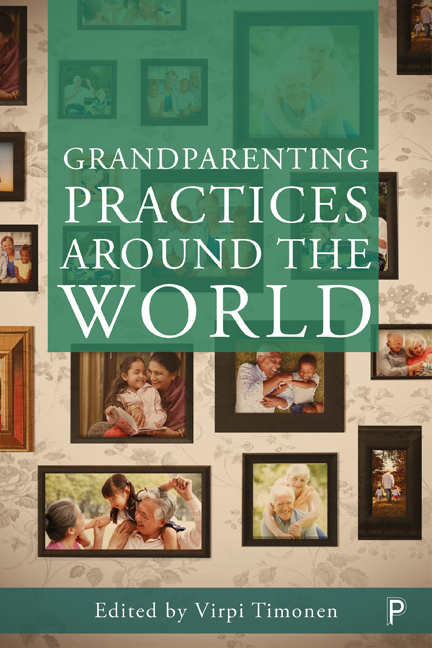Book contents
- Frontmatter
- Contents
- List of figures and tables
- List of abbreviations
- Notes on contributors
- one Introduction: widening the lens on grandparenting
- PART 1 The demographic and welfare-state contexts of grandparenting
- PART 2 Grandparenting in contexts of economic and societal development
- PART 3 Transnational grandparenting
- PART 4 Gender, intersectionalities and grandparenting
- PART 5 Grandparental roles, agency and influence
- Index
eight - The composition of grandparent childcare: gendered patterns in cross-national perspective
Published online by Cambridge University Press: 22 April 2022
- Frontmatter
- Contents
- List of figures and tables
- List of abbreviations
- Notes on contributors
- one Introduction: widening the lens on grandparenting
- PART 1 The demographic and welfare-state contexts of grandparenting
- PART 2 Grandparenting in contexts of economic and societal development
- PART 3 Transnational grandparenting
- PART 4 Gender, intersectionalities and grandparenting
- PART 5 Grandparental roles, agency and influence
- Index
Summary
Introduction
Internationally, grandparents are important providers of childcare while their adult children participate in work and other activities. There is a growing body of literature that explores grandparents’ experiences of providing childcare and the effects it has on their lives. This research indicates most grandparents enjoy caring for their grandchildren and derive many benefits for their health, wellbeing and family relationships (Goodfellow and Laverty, 2003; Ochiltree, 2006). But there can also be costs for grandparents. Lack of choice over their childcare responsibilities or particularly demanding childcare responsibilities (for example, long or nonstandard hours or lack of support from a partner) can have a negative effect on grandparents’ wellbeing (Hamilton and Jenkins, 2015). Care responsibilities can also have an impact on grandparents’ workforce participation, retirement decisions and incomes (Hamilton and Jenkins, 2015).
There is also an emerging body of literature that examines the characteristics of grandparent childcare providers and the prevalence and intensity of grandparent childcare; that is, how often they provide care and for how long (Craig and Jenkins, 2016; Glaser et al., 2013; Timonen and Arber, 2012). This literature suggests that the prevalence and intensity of childcare provision varies by country (Glaser et al., 2013; Herlofson and Hagestad, 2012) and according to patterns of employment participation, cultural and gender norms and values, and policy constellations (Glaser et al., 2013). Prevalence and intensity of grandparent childcare is shaped by both parental employment participation and mature-age employment participation. Research suggests there is a direct relationship between parental employment participation and grandparent childcare provision (Glaser et al., 2013; Hamilton and Jenkins, 2015). In countries with higher participation rates among older people, the prevalence of regular grandparent childcare provision is lower (Glaser et al., 2013). Gender norms and values about work and familial care provision also shape the extent and intensity of grandparent childcare within countries (Glaser et al., 2013). Patterns in grandparental childcare also differ across policy contexts, with different constellations of work and family policies (Arber and Timonen, 2012; Ghysels, 2011; Glaser et al., 2013). Research is lacking, however, on the composition of grandparent childcare time and whether this varies across countries.
- Type
- Chapter
- Information
- Grandparenting Practices around the World , pp. 151 - 170Publisher: Bristol University PressPrint publication year: 2018

